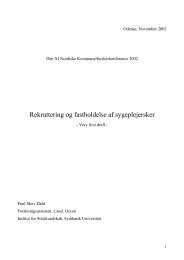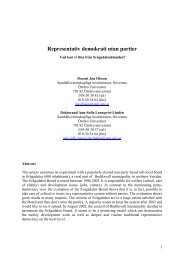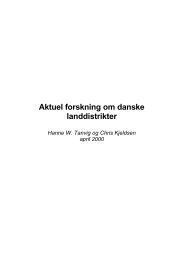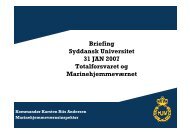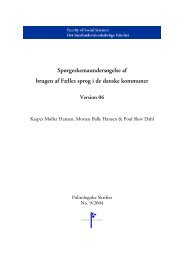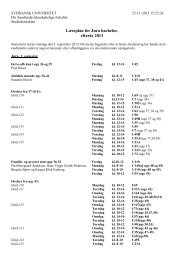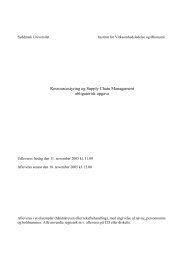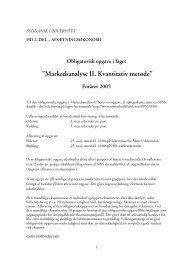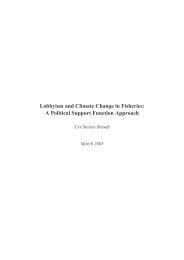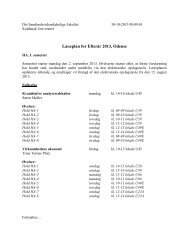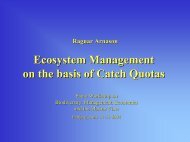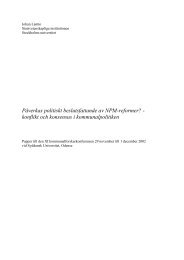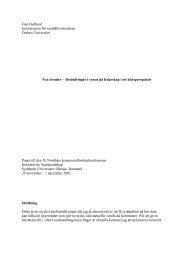20 HOMANS AND WILEN The comparative statics properties summarized in Table I assume an ‘‘interior’’ equilibrium in the sense that the fishery is characterized by a joint equilibrium where regulations are binding. Circumstances where active regulation is necessary exist where there is an equilibrium intersection <strong>of</strong> the two equations representing the industry and regulator behavior. The circumstances which will lead to a regulated open access equilibrium can be described as follows. Begin with the relationship which describes the level <strong>of</strong> cumulative effort ET defined as max 1 PqX 0 ETmax ln Ž B1. q for some arbitrary level <strong>of</strong> biomass X 0. Note that this defines a rectangular hyperbola in E, T space and hence can be compared with the regulatory agency’s choice which is also defined by a rectangular hyperbola, namely 1 X 0 ETreg ln . Ž B2. q Ž 1 d. X0c A joint or binding temporary regulatory equlibrium occurs whenever the maximum level <strong>of</strong> effort which dissipates unregulated rents or ETmax is greater than the amount <strong>of</strong> total fishing effort desired by the regulatory agency ET reg. Thus the condition for existence <strong>of</strong> a temporary regulatory equilibrium is PqX0 X0 ETmax ETreg . Ž B3. Ž 1 d. X0c Thus a regulated equilibrium is likely to occur when P, q, or X0 are large, or when is small, or whenever d or c are small. Note that d small implies that regulators are particularly concerned about high exploitation rates. The above refers to the Ž temporary equilibrium. case where X0 is some arbitrary value which could <strong>of</strong> course be its long run open access steady state value. In general, however, a full long run equilibrium must not only have the industry earning zero rents, but the biomass must also be in equilibrium at that state. The long run steady state biomass level that would evolve in an unregulated Ž Gordon. system is ' 2 Ž . Ž . a 1 1 a 4bPq XG , Ž B4. 2b while the biomass level that would emerge in a regulated open access system is given by Eq. Ž 11. in the text. The complete characterization <strong>of</strong> necessary conditions for a binding long run regulated open access equilibrium is given when these are inserted into Eq. Ž B3. above, or PqXG Xsafe . Ž B5. Ž 1d. Xsafe c
REGULATED OPEN ACCESS RESOURCE USE 21 REFERENCES 1. J. Bhagwati, Directly unproductive pr<strong>of</strong>it seeking activities, J. Polit. Econom. 90, 9881002 Ž 1982 .. 2. J. Buchanan, R. Tollison, and G. Tullock Ž Eds. ., ‘‘Toward a Theory <strong>of</strong> a Rent Seeking Society,’’ Texas A & M Univ. Press, College Station Ž 1980 .. 3. S. Capalbo, ‘‘Bioeconomic Supply and Imperfect Competition: The Case <strong>of</strong> the North Pacific Halibut Industry,’’ Ph.D. dissertation, University <strong>of</strong> California at Davis Ž 1982 .. 4. B. Cook, ‘‘Optimal Harvest Levels for Canada’s Pacific Halibut Fishery,’’ Ph.D. dissertation, Simon Fraser University Ž 1983 .. 5. J. Conklin and W. Kolberg, Chaos for the halibut?, Mar. Resour. Econom. 9, 159182 Ž 1994 .. 6. K. Criddle, ‘‘<strong>Model</strong>ing Dynamic Nonlinear Systems,’’ Ph.D. dissertation, University <strong>of</strong> California at Davis Ž 1989 .. 7. K. Criddle and A. Havenner, Forecasting halibut biomass using systems theoretic time series, Amer. J. Agr. Econom. 71, 422431 Ž 1989 .. 8. J. Crutchfield and A. Zellner, ‘‘Economic Aspects <strong>of</strong> the Pacific Halibut Fishery,’’ U.S. Department <strong>of</strong> the Interior, Fishery Industrial Research, Washington, DC Ž 1962 .. 9. R. Deriso, Risk averse harvesting strategies, in ‘‘<strong>Resource</strong> Management: Proceedings <strong>of</strong> the Second Ralf Yorque Workshop, Lecture Notes in Biomathematics’’ Ž M. Mangel, Ed. ., Springer-Verlag, Berlin Ž 1985 .. 10. H. S. Gordon, The economic theory <strong>of</strong> a common property resource: The fishery, J. Polit. Econom. 62, 124142 Ž 1954 .. 11. L. P. Hansen, Large sample properties <strong>of</strong> generalized method <strong>of</strong> moments estimators, Econometrica 50, 10291054 Ž 1982 .. 12. R. Hilborn and C. J. Walters, ‘‘Quantitative Fisheries Stock Assessment: Choice, Dynamics, and Uncertainty,’’ Chapman and Hall, New York Ž 1992 .. 13. F. R. Homans, ‘‘<strong>Model</strong>ing <strong>Regulated</strong> <strong>Open</strong> <strong>Access</strong> <strong>Resource</strong> <strong>Use</strong>,’’ Ph.D. dissertation, University <strong>of</strong> California at Davis, Ž 1993 .. 14. J. Karp<strong>of</strong>f, Suboptimal controls in common resource management: The case <strong>of</strong> the fishery, J. Polit. Econom. 95, 179194 Ž 1987 .. 15. D. Ludwig and C. J. Walters, A robust method for parameter estimation from catch and effort data, Canad. J. Fish. Aquat. Sci. 46, 137144 Ž 1989 .. 16. T. Quinn, R. Deriso, and S. Hoag, ‘‘Methods <strong>of</strong> Population Assessment <strong>of</strong> Pacific Halibut,’’ International Pacific Halibut Commission Scientific Report No. 72 Ž 1985 .. 17. C. Rowley, R. Tollison, and G. Tullock Ž Eds. ., ’’The Political Economy <strong>of</strong> Rent Seeking,’’ Kluwer Academic, Boston Ž 1988 .. 18. A. Scott, The fishery: The objectives <strong>of</strong> sole ownership, J. Polit. Econom. 63, 116124 Ž 1955 .. 19. ‘‘SHAZAM <strong>Use</strong>r’s Reference Manual Version 7.0,’’ McGrawHill, New York Ž 1993 .. 20. B. Skud, ‘‘Revised Estimates <strong>of</strong> Halibut Abundance and the ThompsonBurkenroad Debate,’’ International Pacific Halibut Commission Scientific Report No. 63 Ž 1975 .. 21. K. Stollery, A short-run model <strong>of</strong> capital stuffing in the Pacific Halibut Fishery, Mar. Resour. Econom. 9, 137153 Ž 1986 .. 22. R. Turvey, and J. Wiseman Ž Eds. ., ‘‘The Economics <strong>of</strong> Fisheries,’’ FAO, Rome Ž 1957 .. 23. U.S. Department <strong>of</strong> Commerce, National Ocean and Atmospheric Administration, Draft Environmental Impact Statement for Proposed Individual Quota Management Alternatives for the Halibut Fisheries in the Gulf <strong>of</strong> Alaska and Bering SeaAleutian Islands, July Ž 1991 .. 24. J. E. Wilen, Towards a theory <strong>of</strong> the regulated fishery, Mar. Resour. Econom. 1, 369388 Ž 1985 .. 25. J. E. Wilen and F. R. Homans, Marketing losses in regulated open access fisheries, in ‘‘Fisheries Economics and Trade: Proceedings <strong>of</strong> the Sixth Conference’’ Ž J. Catanzano, Ed. . IFREMER- SEM Ž 1994 .. 26. J. E. Wilen and F. R. Homans, Unraveling rent losses in modern fisheries: Production, market, or regulatory inefficiencies? ‘‘Fisheries ManagementGlobal Trends’’ ŽD. Huppert, E. Pikitch, and M. Sissenwine, Eds. . Univ. <strong>of</strong> Washington Press, Seattle, 1997.



